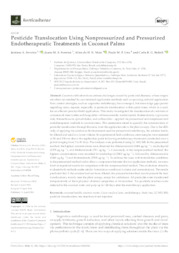Embrapa Tabuleiros Costeiros
 Publicações
Publicações
Pesticide translocation using nonpressurized and pressurized endotherapeutic treatments in coconut palms.
Autoria: FERREIRA, J. A.; FERREIRA, J. M. S.; MAIA, A. de H. N.; LINS, P. M. P.; BOTTOLI, C. B. G.
Resumo: Abstract: Coconut cultivation faces serious challenges caused by pests and diseases, whose targets are often not reached by conventional application methods such as spraying and soil application. New control strategies, such as vegetative endotherapy, have emerged, but knowledge gaps persist regarding many aspects, especially in pesticide translocation within palm trees, which is crucial for an efficient practical field application. This study investigated the translocation of a mixture of commercial insecticides and fungicides—difenoconazole, imidacloprid, thiabendazole, cyproconazole, thiamethoxam, spirodiclofen, and carbosulfan—applied via pressurized and nonpressurized endotherapeutic methods to coconut stems. This assessment aimed to quantify the concentrations of pesticide translocation through the stem, from the application site to the plant canopy. Due to the difficulty of applying the solution to the instrument used for pressurized endotherapy, the solution had to be diluted and used at a lower volume. In experimental field conditions, stem samples were assessed at 50 and 100 cm above the application point following endotherapy treatments conducted over a period ranging from 2 to 45 days. The analyses were performed using LC-MS/MS. In the pressurized method, the highest concentrations were observed for difenoconazole (1684 µg kg?1), imidacloprid (1278 µg kg?1), and thiabendazole (781 µg kg?1). Conversely, in the nonpressurized method, the highest concentrations were recorded for imidacloprid (5803 µg kg?1), followed by difenoconazole (3660 µg kg?1) and thiabendazole (2598 µg kg?1). To address the issue with formulation conditions in the pressurized method and to allow a comparison between the two application methods, we simulated extrapolated results for comparison with the nonpressurized method. This evaluation aimed to evaluate both methods under similar formulation conditions (volume and concentration). The results predicted that if the solution had not been diluted, the pressurized method would present the best translocations, mainly near the plant canopy, except for carbofuran. All pesticides were translocated independently of their physical–chemical properties or formulation. No pesticide residues were detected in the coconut water and pulp up to 120 days after the endotherapy application.
Ano de publicação: 2024
Tipo de publicação: Artigo de periódico
Unidade: Embrapa Tabuleiros Costeiros
Palavras-chave: Coco, Controle Químico, Doença de Planta, Endoterapia, Endotherapy, Fungicida, Inseticida, Translocação
